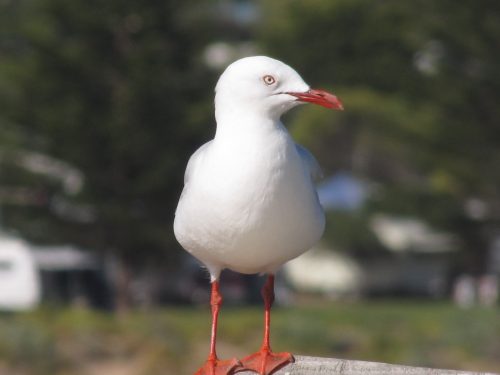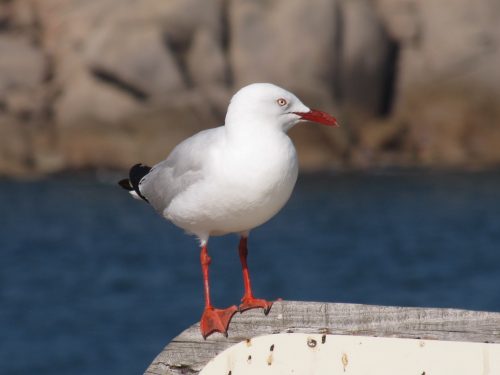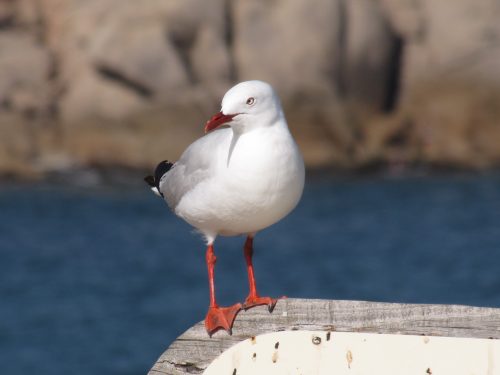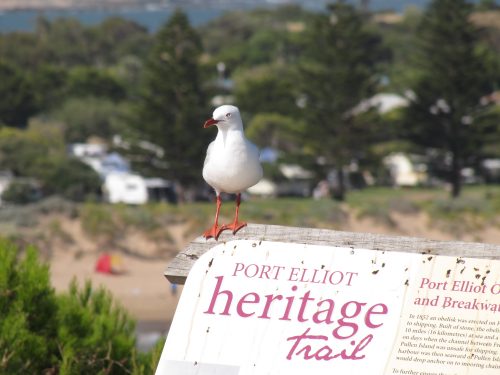Nice pose for a Silver Gull
Earlier this week my wife and I celebrated another anniversary. My – how the years have flown by. We always try to do something special for our anniversary and agreed that the weather was suitable for a long drive and a picnic, finished by dinner at a favourite restaurant. After an early morning chat on the phone with our grandchildren, we set off towards Milang, which is about 50 kilometres from our home. We stopped at the local bakery to buy our lunch, a Cornish pasty each, and a large lamington to share.
We took our lunch down to the shore of Lake Alexandrina and had a picnic lunch on the lawns there. The largest river system in Australia, The Murray-Darling Basin, flows into this large lake, which in turn empties into the Southern Ocean near Goolwa. While we ate our lunch we watched some children playing with their dogs and on the playground. I took note of the birds I could see or hear, but things were rather quiet on that front – until someone disturbed a large flock of very noisy Little Corellas nearby. I have often thought that I would like to stay in the local caravan park right next to the lake, but I concluded that you would not need an alarm clock; the parrots would see that you woke at dawn, or even at first light.
From Milang we drove on towards Goolwa and explored Hindmarsh Island – but I will write about that part another day. Later in the afternoon, we stopped at Horseshoe Bay, Pt Elliot. This small town on the south coast of the Fleurieu Peninsula is a popular holiday destination, being just over an hour’s drive from Adelaide. We stopped for a cuppa and some homemade biscuits in the car park at the lookout. I parked so that we had a great view over the bay. In South Australian history, this spot is quite important. Encounter Bay, which stretches for some distance to the south-east, was where English explorer Captain Matthew Flinders and the French explorer Nicolas Baudin met in April 1802.
While we were having our cuppa, a solitary Silver Gull settled on an interpretive sign just in front of our car. It obligingly posed for a series of photos which I am sharing here today. Silver Gulls are the most common gull found all around the coastline of Australia. It can also be seen far inland where suitable bodies of water exist, such as river systems, lakes, reservoirs and swamps. It can be very common in large numbers at rubbish tips, ovals, picnic grounds and beaches.
Further reading:
Little Corellas pay a visit
Little Corellas are very common around our district here in the Murraylands of South Australia. Along the River Murray and in some parks around town flocks of 200 to 500 are common. And very noisy – not to mention destructive when they start chewing on the trees in the parks. This morning I visited the Farmers’ Markets held at Sturt Reserve on the banks of the river and I saw flocks of 50 or more in a number of spots, most of the birds on the grass feeding.
Despite these large numbers in our district we rarely have then visiting our garden, even though we live only 5km from the river. I’m not sure of the reason for this. Perhaps they have access to more food along the river, perhaps there are more nesting hollows there or it could be some other factor at play.
When we do have a flock fly over like it did this week, we immediately can tell they are around due to their raucous call. It’s not something easily ignored. The flock this week was only about 60 strong but they still made quite a racket.
Two Galahs and a Corella
I took this photo of two Galahs in the aviary next to the Pinnaroo Caravan Park last week. Rather sad looking birds if you ask me. I guess they’d rather be out in the fields pinching the seeds from a farmer’s wheat crop. At least they have each other – many parrots mate for life. It’s a little hard to tell but by digitally enlarging the photo it looks like the one on the left is a male, the other a female. (Males have dark brown eyes, females red eyes).
Even sadder is the solitary Little Corella shown below.






